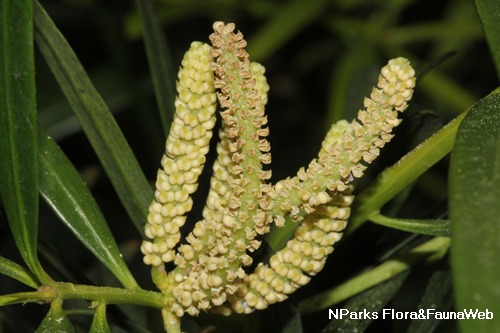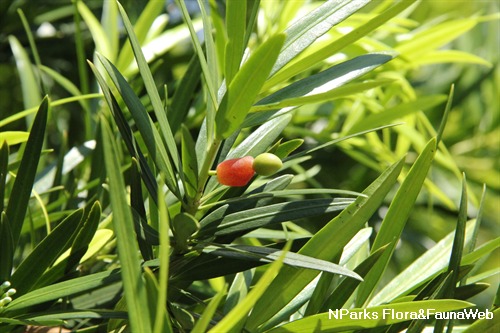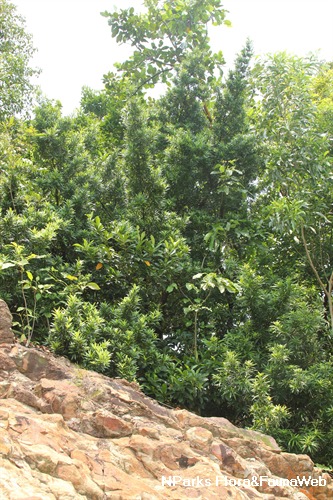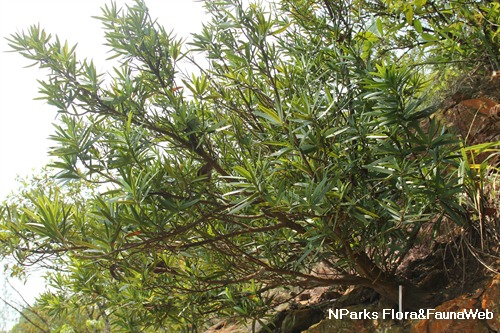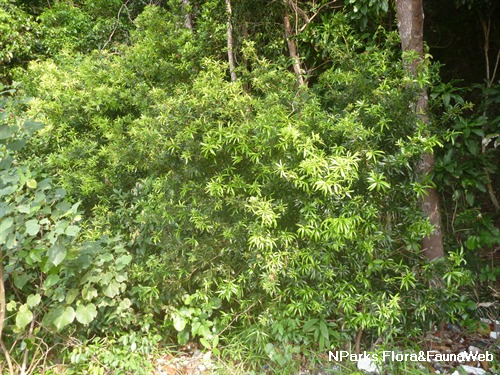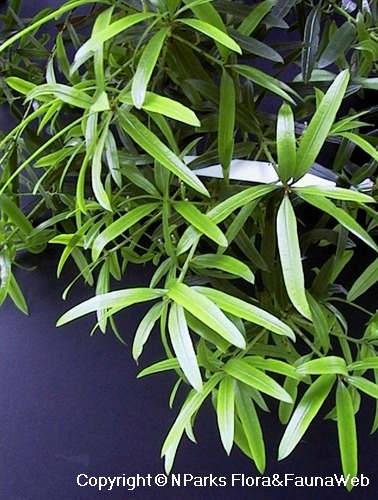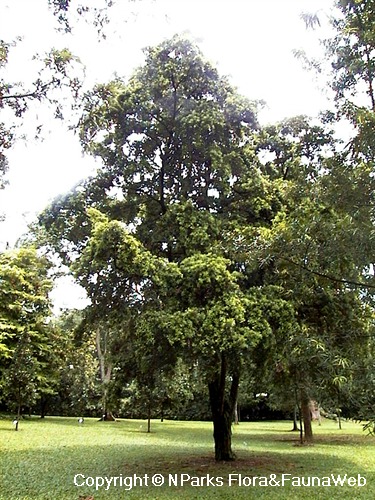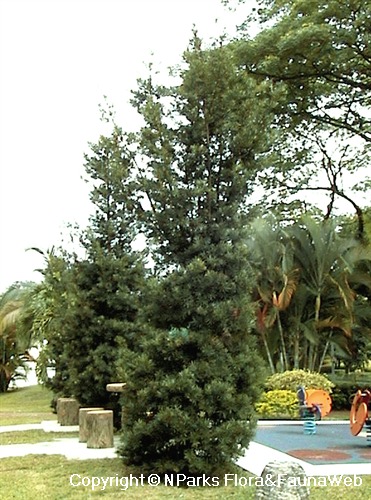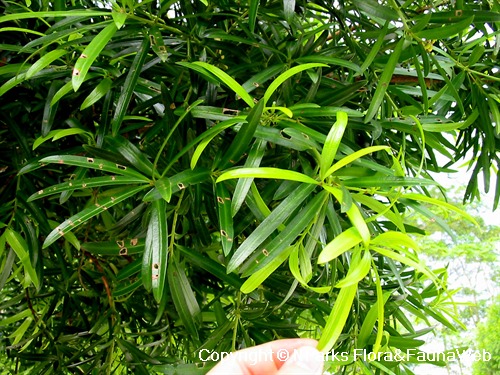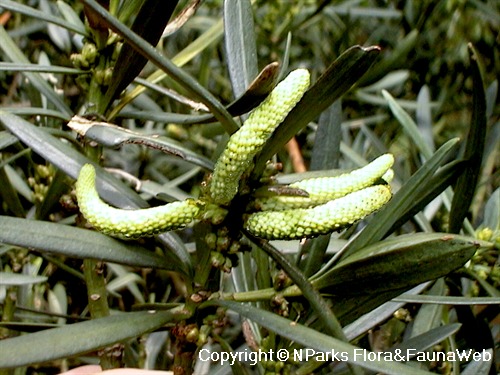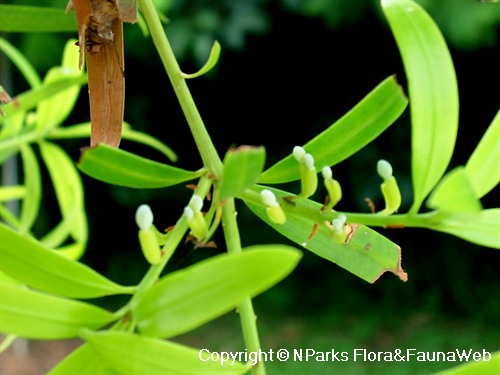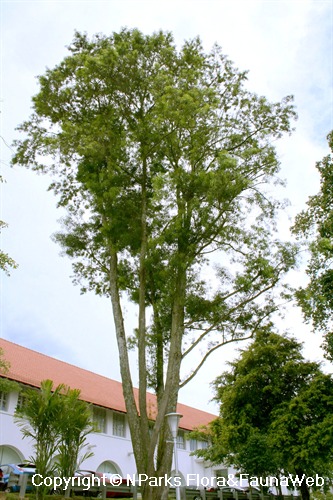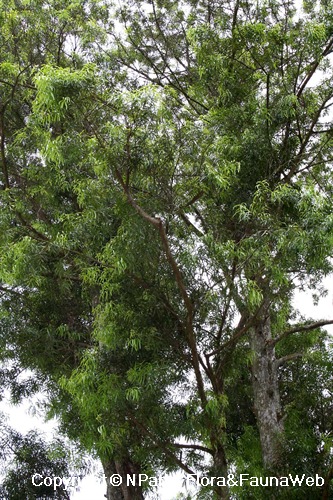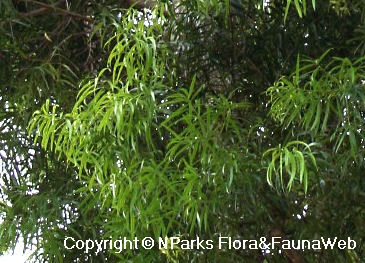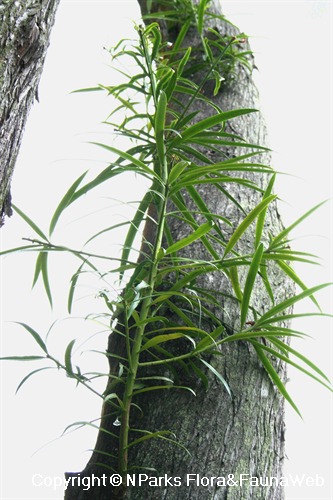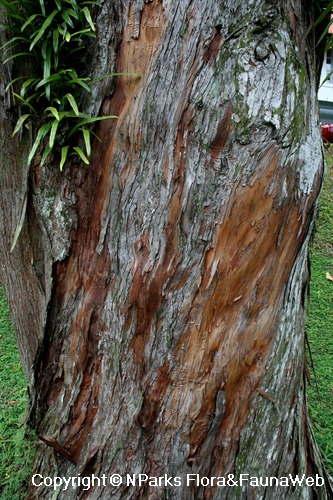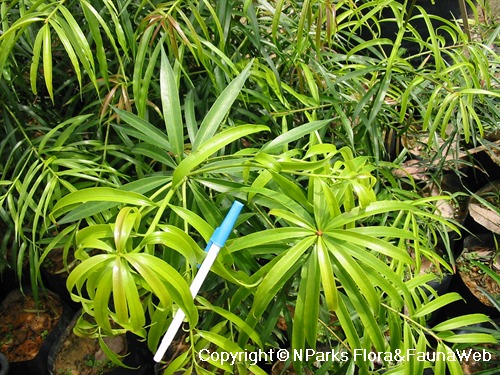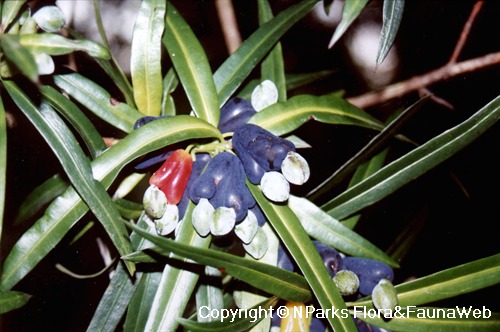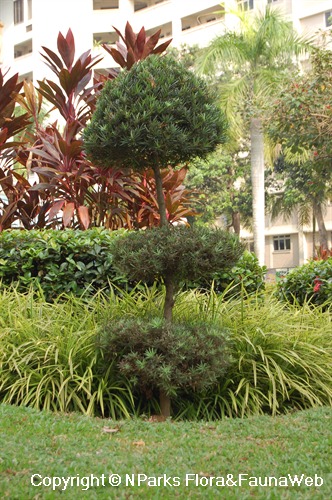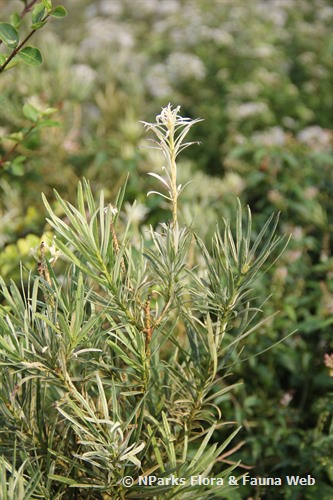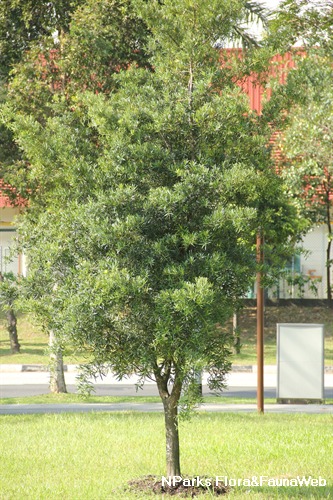
Back
Podocarpus polystachyus R.Br. ex Endl.
| Family Name: | Podocarpaceae |
| Synonyms: | Nageia polystachia, Nageia thevetiaefolia, Podocarpus thevetiaefolius |
| Common Name: | Sea Teak, Jati Laut, Jati Bukit, Podo Laut, Setada, Sentada, Sintada, 印度蓝屿罗汉松 |
Name
Classifications and Characteristics
| Plant Division | Gymnosperms (Non-Flowering Seed Plants) (Conifer) |
|---|---|
| Plant Growth Form | Tree (Medium (16m-30m)) |
| Lifespan (in Singapore) | Perennial |
| Mode of Nutrition | Autotrophic |
| Plant Shape | Irregular |
| Maximum Height | 20 m |
Biogeography
| Native Distribution | Peninsular Malaysia, Singapore, Riow-Lingga and Bangka Islands, the Philippines, Borneo, the Moluccas, and New Guinea |
|---|---|
| Native Habitat | Shoreline (Mangrove Forest, Sandy Beach, Coastal Cliff, Rocky Beach) |
| Preferred Climate Zone | Tropical |
| Local Conservation Status | Native to Singapore (Endangered (EN)) |
Description and Ethnobotany
| Growth Form | It is an evergreen, coniferous tree, up to 20 m tall. |
|---|---|
| Crown | Its crown is broadly conical to dome-shaped in young trees, becoming irregular with age. |
| Foliage | Its alternate, shortly-stalked leaves have leathery leaf blades that are narrowly lance-shaped, dark green, and 2.5–12 by 0.5–1.3 cm. |
| Reproductive Parts - non-flowering plant | It is a dioecious species, with male and female cones borne on separate trees. The cream-coloured, cylindrical male cones develop in clusters of 3–5, and are each 2–4.5 cm long. The female cones develop singly, and consist of a single ovule up to 8 mm long on a fleshy, somewhat cylindrical receptacle about 6 mm long. The receptacle becomes red when the ovule becomes a mature seed, after pollination and fertilisation. The seed is green upon maturity, with a fleshy bright or dark red receptacle. |
| Others - Plant Morphology | When grown in windswept conditions, tree may assume bent and gnarled form. |
| Habitat | It usually grows along rocky and sandy seashores, in the landward edge of mangrove forest, and coastal cliffs. |
| Associated Fauna | The seeds and the attached fleshy receptacles are eaten by birds and bats. |
| Cultivation | It can be propagated by seed. |
| Etymology | Genus name 'Podocarpus' means 'fruit foot', a reference to the swollen receptable holding the seed. Species epithet 'polystachyus' means 'many ears of corn', a description of the clustered male cones. |
| Ethnobotanical Uses | Food (Fruit or Vegetable): The swollen, red receptacle is edible and sweet. Medicinal: Leaves may be used to treat painful and rheumatic joints. Timber & Products: It is an important source of softwood timber called Podo Wood or Podocarp timber. The wood is used as light to medium-weight softwood timber for interiorwork, beams, framing, furniture and oars. Wood is not weatherproof or insect resistant. Cultural / Religious: Heritage Tree: There is currently one individual of Podocarpus polystachyus listed as Heritage Tree in Singapore. To find out more about this tree, please visit the Heritage Tree Register. |
Landscaping Features
| Landscaping | It may be planted as bonsai. It is also tolerant of many soil types. It is a tree suitable for gardens, parks and roadsides. |
|---|---|
| Desirable Plant Features | Ornamental Fruits, Ornamental Foliage, Ornamental Form |
| Landscape Uses | Container Planting, General, Suitable for Roadsides, Coastal, Suitable for Bonsai, Parks & Gardens, Small Gardens, Beachfront / Shoreline, Hedge / Screening |
| Thematic Landscaping | Naturalistic Garden |
Fauna, Pollination and Dispersal
| Fauna Pollination Dispersal Associated Fauna | Bird-Attracting (Fruits) |
|---|---|
| Pollination Method(s) | Abiotic (Wind) |
| Seed or Spore Dispersal | Biotic (Fauna) |
Plant Care and Propagation
| Light Preference | Full Sun |
|---|---|
| Water Preference | Moderate Water |
| Plant Growth Rate | Slow |
| Rootzone Tolerance | Saline Soils / Salt Spray, Waterlogged Soils (Drains Site), Easy to Grow, Fertile Loamy Soils, Well-Drained Soils, Poor Infertile Soils, Drought Tolerant |
| Maintenance Requirements | Moderate |
| Diseases | Growing shoots cccasionally attacked by blue-grey aphids, causing leaf distortion. |
| Propagation Method | Seed, Stem Cutting, Air-Layering |
| Plant Growth Rate Remarks | Slow |
| Propagation Method Remarks | Seeds remain viable for only 3 months. |
Foliar
| Foliage Retention | Evergreen |
|---|---|
| Mature Foliage Colour(s) | Green |
| Mature Foliage Texture(s) | Smooth, Glossy / Shiny, Thick, Leathery |
| Prominent Young Flush Colour(s) | Green - Light Green |
| Foliar Type | Simple / Unifoliate |
| Foliar Arrangement Along Stem | Alternate |
| Foliar Attachment to Stem | Petiolate |
| Foliar Shape(s) | Non-Palm Foliage (Lanceolate, Linear) |
| Foliar Margin | Entire |
| Foliar Apex - Tip | Acute |
| Foliar Base | Cuneate |
| Typical Foliar Area | Notophyll ( 20.25cm2 - 45 cm2 ) |
| Leaf Area Index (LAI) for Green Plot Ratio | 3.0 (Tree - Intermediate Canopy) |
Non - Foliar and Storage
| Trunk Type (Non Palm) | Woody |
|---|---|
| Bark Colour(s) | Greyish-brown to dark brown |
| Mature Bark Texture | Fissured, Peeling / Flaking / Papery, Cracked |
| Stem Type & Modification | Woody |
| Root Type | Underground (Tap Root, Fibrous Root) |
Floral (Angiosperm)
| Flower & Plant Sexuality | Unisexual Flowers , Dioecious |
| Flower Colour(s) | Cream / Off-White |
|---|
| Flower Size - Remarks | Male cones: 2.0 - 4.5 cm long x 0.3cm wide Female cones: 0.6- 0.8 cm long ovule on fleshy receptacle |
| Flowering Habit | Polycarpic |
Fruit, Seed and Spore
| Mature Fruit Colour(s) | Red |
|---|---|
| Mature Seed Colour(s) | Green |
| Plant Sexuality (non-Angiosperm) | Dioecious |
| Reproductive Mode (non-Angiosperm) | Sexual |
| Cone or Strobilus Type | Epispermatium(Podocarpaceae) |
Image Repository
Others
| Master ID | 1784 |
|---|---|
| Species ID | 3077 |
| Flora Disclaimer | The information in this website has been compiled from reliable sources, such as reference works on medicinal plants. It is not a substitute for medical advice or treatment and NParks does not purport to provide any medical advice. Readers should always consult his/her physician before using or consuming a plant for medicinal purposes. |

